Abstract
Current antibiotics tend to be broad spectrum, leading to indiscriminate killing of commensal bacteria and accelerated evolution of drug resistance. Here, we use CRISPR-Cas technology to create antimicrobials whose spectrum of activity is chosen by design. RNA-guided nucleases (RGNs) targeting specific DNA sequences are delivered efficiently to microbial populations using bacteriophage or bacteria carrying plasmids transmissible by conjugation. The DNA targets of RGNs can be undesirable genes or polymorphisms, including antibiotic resistance and virulence determinants in carbapenem-resistant Enterobacteriaceae and enterohemorrhagic Escherichia coli. Delivery of RGNs significantly improves survival in a Galleria mellonella infection model. We also show that RGNs enable modulation of complex bacterial populations by selective knockdown of targeted strains based on genetic signatures. RGNs constitute a class of highly discriminatory, customizable antimicrobials that enact selective pressure at the DNA level to reduce the prevalence of undesired genes, minimize off-target effects and enable programmable remodeling of microbiota.
This is a preview of subscription content, access via your institution
Access options
Subscribe to this journal
Receive 12 print issues and online access
$209.00 per year
only $17.42 per issue
Buy this article
- Purchase on Springer Link
- Instant access to full article PDF
Prices may be subject to local taxes which are calculated during checkout




Similar content being viewed by others
References
Centers for Disease Control and Prevention. Antibiotic Resistance Threats in the United States (2013).
Nordmann, P., Dortet, L. & Poirel, L. Carbapenem resistance in Enterobacteriaceae: here is the storm!. Trends Mol. Med. 18, 263–272 (2012).
Barrangou, R. et al. CRISPR provides acquired resistance against viruses in prokaryotes. Science 315, 1709–1712 (2007).
Garneau, J.E. et al. The CRISPR/Cas bacterial immune system cleaves bacteriophage and plasmid DNA. Nature 468, 67–71 (2010).
Mali, P., Esvelt, K.M. & Church, G.M. Cas9 as a versatile tool for engineering biology. Nat. Methods 10, 957–963 (2013).
Deltcheva, E. et al. CRISPR RNA maturation by trans-encoded small RNA and host factor RNase III. Nature 471, 602–607 (2011).
Jinek, M. et al. A programmable dual-RNA-guided DNA endonuclease in adaptive bacterial immunity. Science 337, 816–821 (2012).
Rasheed, J.K. et al. Characterization of the extended-spectrum beta-lactamase reference strain, Klebsiella pneumoniae K6 (ATCC 700603), which produces the novel enzyme SHV-18. Antimicrob. Agents Chemother. 44, 2382–2388 (2000).
Rasheed, J.K. et al. New Delhi metallo-β-lactamase-producing Enterobacteriaceae, United States. Emerg. Infect. Dis. 19, 870–878 (2013).
Bikard, D., Hatoum-Aslan, A., Mucida, D. & Marraffini, L.A. CRISPR interference can prevent natural transformation and virulence acquisition during in vivo bacterial infection. Cell Host Microbe 12, 177–186 (2012).
Gomaa, A.A. et al. Programmable removal of bacterial strains by use of genome-targeting CRISPR-Cas systems. MBio 5, e00928–13 (2014).
Lutz, R. & Bujard, H. Independent and tight regulation of transcriptional units in Escherichia coli via the LacR/O, the TetR/O and AraC/I1–I2 regulatory elements. Nucleic Acids Res. 25, 1203–1210 (1997).
Pérez-Mendoza, D. & de la Cruz, F. Escherichia coli genes affecting recipient ability in plasmid conjugation: are there any? BMC Genomics 10, 71 (2009).
Jacoby, G.A. Mechanisms of resistance to quinolones. Clin. Infect. Dis. 41 (suppl. 2), S120–S126 (2005).
Pennington, J.M. & Rosenberg, S.M. Spontaneous DNA breakage in single living Escherichia coli cells. Nat. Genet. 39, 797–802 (2007).
Hayes, F. Toxins-antitoxins: plasmid maintenance, programmed cell death, and cell cycle arrest. Science 301, 1496–1499 (2003).
Mnif, B. et al. Molecular characterization of addiction systems of plasmids encoding extended-spectrum beta-lactamases in Escherichia coli. J. Antimicrob. Chemother. 65, 1599–1603 (2010).
Kaper, J.B., Nataro, J.P. & Mobley, H.L. Pathogenic Escherichia coli. Nat. Rev. Microbiol. 2, 123–140 (2004).
Desbois, A.P. & Coote, P.J. Utility of greater wax moth larva (Galleria mellonella) for evaluating the toxicity and efficacy of new antimicrobial agents. Adv. Appl. Microbiol. 78, 25–53 (2012).
Sonnenburg, J.L. & Fischbach, M.A. Community health care: therapeutic opportunities in the human microbiome. Sci. Transl. Med. 3, 78ps12 (2011).
Paddon, C.J. et al. High-level semi-synthetic production of the potent antimalarial artemisinin. Nature 496, 528–532 (2013).
Duan, F. & March, J.C. Engineered bacterial communication prevents Vibrio cholerae virulence in an infant mouse model. Proc. Natl. Acad. Sci. USA 107, 11260–11264 (2010).
Lu, T.K. & Collins, J.J. Dispersing biofilms with engineered enzymatic bacteriophage. Proc. Natl. Acad. Sci. USA 104, 11197–11202 (2007).
Lu, T.K. & Collins, J.J. Engineered bacteriophage targeting gene networks as adjuvants for antibiotic therapy. Proc. Natl. Acad. Sci. USA 106, 4629–4634 (2009).
Edgar, R., Friedman, N., Molshanski-Mor, S. & Qimron, U. Reversing bacterial resistance to antibiotics by phage-mediated delivery of dominant sensitive genes. Appl. Environ. Microbiol. 78, 744–751 (2012).
Seed, K.D., Lazinski, D.W., Calderwood, S.B. & Camilli, A. A bacteriophage encodes its own CRISPR/Cas adaptive response to evade host innate immunity. Nature 494, 489–491 (2013).
Jiang, W., Bikard, D., Cox, D., Zhang, F. & Marraffini, L.A. RNA-guided editing of bacterial genomes using CRISPR-Cas systems. Nat. Biotechnol. 31, 233–239 (2013).
Vercoe, R.B. et al. Cytotoxic chromosomal targeting by CRISPR/Cas systems can reshape bacterial genomes and expel or remodel pathogenicity islands. PLoS Genet. 9, e1003454 (2013).
Williams, J.J. & Hergenrother, P.J. Artificial activation of toxin-antitoxin systems as an antibacterial strategy. Trends Microbiol. 20, 291–298 (2012).
Esvelt, K.M., Smidler, A.L., Catteruccia, F. & Church, G.M. Concerning RNA-guided gene drives for the alteration of wild populations. Elife e03401 (2014).
Datta, S., Costantino, N. & Court, D.L. A set of recombineering plasmids for Gram-negative bacteria. Gene 379, 109–115 (2006).
Gibson, D.G. et al. Enzymatic assembly of DNA molecules up to several hundred kilobases. Nat. Methods 6, 343–345 (2009).
Sikorski, R.S. & Hieter, P. A system of shuttle vectors and yeast host strains designed for efficient manipulation of DNA in Saccharomyces cerevisiae. Genetics 122, 19–27 (1989).
Dwyer, D.J., Kohanski, M.A., Hayete, B. & Collins, J.J. Gyrase inhibitors induce an oxidative damage cellular death pathway in Escherichia coli. Mol. Syst. Biol. 3, 91 (2007).
Clinical and Laboratory Standards Institute. Methods for Dilution Antimicrobial Susceptibility Tests for Bacteria that Grow Aerobically; Approved Standard. Seventh Edition. (Clinical and Laboratory Standards Institute, Wayne, Pennsylvania, USA, 2006).
Chung, C.T., Niemela, S.L. & Miller, R.H. One-step preparation of competent Escherichia coli: transformation and storage of bacterial cells in the same solution. Proc. Natl. Acad. Sci. USA 86, 2172–2175 (1989).
Chasteen, L., Ayriss, J., Pavlik, P. & Bradbury, A.R.M. Eliminating helper phage from phage display. Nucleic Acids Res. 34, e145 (2006).
Westwater, C. et al. Use of genetically engineered phage to deliver antimicrobial agents to bacteria: an alternative therapy for treatment of bacterial infections. Antimicrob. Agents Chemother. 47, 1301–1307 (2003).
Dong, D., Sutaria, S., Hwangbo, J.Y. & Chen, P. A simple and rapid method to isolate purer M13 phage by isoelectric precipitation. Appl. Microbiol. Biotechnol. 97, 8023–8029 (2013).
Ramarao, N., Nielsen-Leroux, C. & Lereclus, D. The insect Galleria mellonella as a powerful infection model to investigate bacterial pathogenesis. J. Vis. Exp. 4392, 10.3791/4392 (2012).
Acknowledgements
We would like to thank R. Meyer (Institute for Cell and Molecular Biology, University of Texas Austin) for R1162, D.L. Court (Center for Cancer Research, National Cancer Institute at Frederick) for pSIM9, and A.R.M. Bradbury (Los Alamos National Laboratory) for M13cp. The authors thank J. Rubens for assistance with flow cytometry experiments and H. Gancz and D. Zurawski for assistance with the Galleria infection model. T.K.L. acknowledges support from the US National Institutes of Health (NIH) New Innovator Award (1DP2OD008435), an NIH National Centers for Systems Biology grant (1P50GM098792), the Defense Threat Reduction Agency (HDTRA1-14-1-0007), the US Army Research Laboratory and the US Army Research Office through the Institute for Soldier Nanotechnologies (W911NF13D0001) and the Henry L. and Grace Doherty Professorship in Ocean Utilization. R.J.C. is supported by funding from the NIH/National Institute of General Medical Sciences Interdepartmental Biotechnology Training Program (5T32 GM008334), and M.M. is a Howard Hughes Medical Institute International Student Research fellow and a recipient of a Fonds de recherche Santé Québec Master's Training Award.
Author information
Authors and Affiliations
Contributions
R.J.C. and M.M. designed and performed experiments. R.J.C., M.M. and T.K.L. conceived this study, analyzed the data, discussed results and wrote the manuscript.
Corresponding author
Ethics declarations
Competing interests
R.J.C., M.M. and T.K.L. have filed a provisional application with the US Patent and Trademark Office on this work.
Supplementary information
Supplementary Text and Figures
Supplementary Figures 1–8, Supplementary Tables 1–4 and Supplementary Discussion (PDF 1560 kb)
Rights and permissions
About this article
Cite this article
Citorik, R., Mimee, M. & Lu, T. Sequence-specific antimicrobials using efficiently delivered RNA-guided nucleases. Nat Biotechnol 32, 1141–1145 (2014). https://doi.org/10.1038/nbt.3011
Received:
Accepted:
Published:
Issue Date:
DOI: https://doi.org/10.1038/nbt.3011
This article is cited by
-
Microbes little helpers and suppliers for therapeutic asthma approaches
Respiratory Research (2024)
-
Utilization of the microbiome in personalized medicine
Nature Reviews Microbiology (2024)
-
Alternative therapeutic strategies to treat antibiotic-resistant pathogens
Nature Reviews Microbiology (2024)
-
CRISPR-Cas System: A New Dawn to Combat Antibiotic Resistance
BioDrugs (2024)
-
CRISPR-Cas9 mediated phage therapy as an alternative to antibiotics
Animal Diseases (2023)



